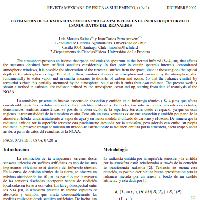Resumen
-
La atmósfera presenta un intenso espectro de absorción y emisión en el infrarrojo térmico ( 8-14 μm), que afecta considerablemente las medidas realizadas desde satélites artificiales. De hecho, tan sólo en ciertos intervalos espectrales, denominados ventanas atmosféricas, es posible la observación de la superficie terrestre desde el espacio, ya que en esas regiones la transmisividad de la atmósfera es alta. Pero aún en estas ventanas existe una absorción y emisión por parte de la atmósfera, debida fundamentalmente al vapor de agua y en menor medida al dióxido de carbono y el ozono. De manera que la radiancia emitida por la superficie terrestre esta parcialmente atenuada por la atmósfera, pero además esta emite su propia
radiancia. El presente trabajo se muestra un método de estimación de la radiancia emitida por la atmósfera, hacia abajo y hacia
arriba, a partir de datos del reanálisis de la NOAA. -
The atmosphere presents an intense absorption and emission spectrum in the thermal infrared (8-14 μm), that affects the measures obtained from artificial satellites considerably. In fact, only in certain spectrals intervals, denominated atmospheric windows, it is possible the observation of the terrestrial surface from the space, since in those regions the optical depth of the atmosphere is high. But still in these windows it exists an absorption and emission by the atmosphere, due fundamentally to water vapor and in smaller measure to dioxide of carbon and ozone. So that the radiance emitted by
terrestrial surface this partially attenuated by the atmosphere, but also this it emits their own radiance. The present work is shown a method to estimate the radiance emitted by the atmosphere, down and up, starting from data of reanalysis of the NOAA.
